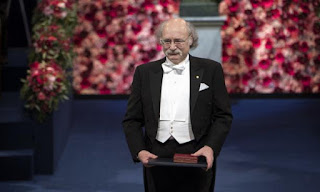In Condensed Matter Physics: A Very Short Introduction I would like to include an Appendix with a list of all the Nobel Prizes related to condensed matter physics. My list includes 31 in Physics and 6 in Chemistry. I acknowledge that a few in my list are debatable. Some of the Chemistry prizes were to people who trained in condensed matter physics but eventually worked in chemistry departments. A few of the physics prizes are closer to electronic engineering than condensed matter. On the one hand, Nambu was not a condensed matter physicist, but he took Anderson's ideas about broken symmetry in superconductivity and applied them to particle physics.
I want to include the list because I find it pretty amazing and it illustrates just how CMP consistently seems to turn up surprising new discoveries. Many of these prizes are mentioned in the text of the VSI.
In writing the book, and particularly the chapter on topological quantum matter, I found that nobelprize.org is very helpful. The popular descriptions for specific prizes contain helpful language, metaphors, images, and anecdotes. The technical descriptions give very nice introductions/summaries of the discoveries associated with the prize. Beginning Ph.D. students may find them very helpful.





Hi Ross, I think it's a good list. The nobel prize site does categorize the fields of the prizes but I support your approach of making your own list.
ReplyDeleteNambu does seem a bit far-fetched to me, but since you were a broad I was surprised you did not include Bohr's prize in it. After all Bohr was lead to discrete orbits because previously he had proven that the Drude model could not describe magnetism in matter. Heck, if you ask me I would put Planck's blackbody there too.
Sin-Itiro Tomonaga's book about Old Quantum Theory stresses that most of the early quantum mechanics was developed in response to solid state experiments.
It's also worth noting that van der Waals' prize comes from work done in 1873, the earliest of all discoveries ever awarded a Nobel prize. I have compiled a list of Nobel prizes by date of discovery/invention instead of the award which I'll be happy to send your way in case you want.
Quasicrystals: a new type of organization in condensed matter--- A papers title
ReplyDeleteThis ruffled many for its forbidden symmetry which included the great Linus Pauling. LP wrote against quasicrystals discovered by Dan Schectman . DS was mechanical engineer with a doctorate in materials engineering. NL in 2011. Pauling known for meticulously maintaining lab notebooks read the Phy Review Letter paper of 1984 and wrote quasicrystals is not possible. LP should have asked DS to display his lab note book where the nitty gritty calculations were made by DS. LP would have got convinced.
In present neoliberal times when lab data is recorded on computers. Pauling's lab notebooks preserved here is a reminder to maintain primary lab data as it is obtained and not tinker with it recorded on computers.
http://scarc.library.oregonstate.edu/coll/pauling/rnb/index.html